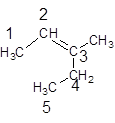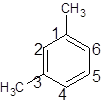
Concept explainers
(a)
Interpretation:
Whether the name 2-ethyl-2-butene is correct or not needs to be determined and the structure of the compound should be drawn.
Concept introduction:
The hydrocarbon compounds contain compound that are made up of only hydrogen and carbon atoms. Hydrocarbon compounds that contains multiple bond(s) are said to be
(a)
Answer to Problem 88A
The name 2-ethyl-2-butene is wrong and the correct name will be 3-methyl-2-pentene and the structure of the compound is:

Explanation of Solution
The given name of compound is 2-ethyl-2-butene so, from the name it can be concluded that the parent chain contains 4 carbon atoms with a double bond at position 2 and an ethyl substituent at carbon 2. So, the structure of the compound will be:

Now, according to IUPAC rules of naming of organic compound the longest carbon chain should be the parent chain containing double bond and substituents at lowest number so the numbering will be:

Hence, the name 2-ethyl-2-butene is wrong and the correct name will be 3-methyl-2-pentene.
(b)
Interpretation:
Whether the name 1, 4-dimethylcyclohexene is correct or not needs to be determined and the structure of the compound should be drawn.
Concept introduction:
The hydrocarbon compounds contain compound that are made up of only hydrogen and carbon atoms. Hydrocarbon compounds that contains multiple bond(s) are said to be unsaturated hydrocarbon. Compounds containing double bonds are said to be alkene whereas compounds containing triple bonds are said to be alkyne.
(b)
Answer to Problem 88A
The name 1, 4-dimethylcyclohexene is correct and the structure of the compound is:

Explanation of Solution
The given name of compound is 1, 4-dimethylcyclohexene so, from the name it can be concluded that the parent chain contains 6 carbon atoms cyclic ring with a double bond at position 1 and two methyl substituents at carbon 1 and 4. So, the structure of the compound will be:

Now, according to IUPAC rules of naming of organic compound the longest carbon chain should be the parent chain containing double bond and substituents at lowest number so the numbering will be:

Hence, the name 1, 4-dimethylcyclohexene is correct.
(c)
Interpretation:
Whether the name 1, 5-dimethylbenzene is correct or not needs to be determined and the structure of the compound should be drawn.
Concept introduction:
Benzene is an
(c)
Answer to Problem 88A
The name 1, 5-dimethylbenzene is wrong and the correct name will be 1, 3-dimethylbenzene and the structure of the compound is:

Explanation of Solution
The given name of compound is 1, 5-dimethylbenzene so, from the name it can be concluded that the parent chain is benzene cyclic ring and two methyl substituents at carbon 1 and 5. So, the structure of the compound will be:

Now, according to IUPAC rules of naming of organic compound the longest carbon chain should be the parent chain and substituents at lowest number so the numbering will be:

Hence, the name 1, 5-dimethylbenzene is wrong and the correct name will be 1, 3-dimethylbenzene.
Chapter 21 Solutions
Chemistry: Matter and Change
Additional Science Textbook Solutions
Introductory Chemistry (6th Edition)
Microbiology: An Introduction
Anatomy & Physiology (6th Edition)
Campbell Biology (11th Edition)
Organic Chemistry (8th Edition)
Cosmic Perspective Fundamentals
- Part 1. Draw monomer units of the following products and draw their reaction mechanism 1) Bakelite like polymer Using: Resorcinol + NaOH + Formalin 2) Polyester fiber Using a) pthalic anhydride + anhydrous sodium acetate + ethylene glycol B)pthalic anhydride + anhydrous sodium acetate + glycerol 3) Temporary cross-linked polymer Using: 4% polyvinyl alcohol+ methyl red + 4% sodium boratearrow_forwardUsing the table of Reactants and Products provided provide the correct letter that corresponds with the Carboxylic acid that is formed in the reaction below. 6 M NaOH Acid-workup WRITE THE CORRECT LETTER ONLY DO NOT WRITE EXTRA WORDS OR PHRASES A) Pool of Reagents for Part B CI B) OH C) E) CI J) racemic F) K) OH N) OH P) G) OH D) HO H) L) M) HO Q) R) CI Aarrow_forwardIn the table below, the exact chemical structures for Methyl salicylate can be represented by the letter WRITE THE CORRECT LETTER ONLY DO NOT WRITE EXTRA WORDS OR PHRASES CI B) A) E) Cl racemic F) J) CI K) N) OH P) Pool of Reagents for Part B OH OH G) L) OH D) HO H) M) HO Q) R) CIarrow_forward
- Draw the stepwise mechanism for the reactionsarrow_forwardPart I. a) Draw reaction mechanism for the transformations of benzophenone to benzopinacol to benzopinaco lone b) Pinacol (2,3-dimethyl, 1-3-butanediol) on treatment w/ acid gives a mixture of pina colone (3,3-dimethyl-2-butanone) and 2, 3-dimethyl - 1,3-butadiene. Give reasonable mechanism the formation of the products Forarrow_forward3. The explosive decomposition of 2 mole of TNT (2,4,6-trinitrotoluene) is shown below: Assume the C(s) is soot-basically atomic carbon (although it isn't actually atomic carbon in real life). 2 CH3 H NO2 NO2 3N2 (g)+7CO (g) + 5H₂O (g) + 7C (s) H a. Use bond dissociation energies to calculate how much AU is for this reaction in kJ/mol.arrow_forward
- Part I. Draw reaction mechanism for the transformations of benzophenone to benzopinacol to benzopinaco lone and answer the ff: Pinacol (2,3-dimethyl, 1-3-butanediol) on treatment w/ acid gives a mixture of pina colone and (3,3-dimethyl-2-butanone) 2,3-dimethyl-1,3-butadiene. Give reasonable mechanism the formation of the products Forarrow_forwardShow the mechanism for these reactionsarrow_forwardDraw the stepwise mechanismarrow_forward
 ChemistryChemistryISBN:9781305957404Author:Steven S. Zumdahl, Susan A. Zumdahl, Donald J. DeCostePublisher:Cengage Learning
ChemistryChemistryISBN:9781305957404Author:Steven S. Zumdahl, Susan A. Zumdahl, Donald J. DeCostePublisher:Cengage Learning ChemistryChemistryISBN:9781259911156Author:Raymond Chang Dr., Jason Overby ProfessorPublisher:McGraw-Hill Education
ChemistryChemistryISBN:9781259911156Author:Raymond Chang Dr., Jason Overby ProfessorPublisher:McGraw-Hill Education Principles of Instrumental AnalysisChemistryISBN:9781305577213Author:Douglas A. Skoog, F. James Holler, Stanley R. CrouchPublisher:Cengage Learning
Principles of Instrumental AnalysisChemistryISBN:9781305577213Author:Douglas A. Skoog, F. James Holler, Stanley R. CrouchPublisher:Cengage Learning Organic ChemistryChemistryISBN:9780078021558Author:Janice Gorzynski Smith Dr.Publisher:McGraw-Hill Education
Organic ChemistryChemistryISBN:9780078021558Author:Janice Gorzynski Smith Dr.Publisher:McGraw-Hill Education Chemistry: Principles and ReactionsChemistryISBN:9781305079373Author:William L. Masterton, Cecile N. HurleyPublisher:Cengage Learning
Chemistry: Principles and ReactionsChemistryISBN:9781305079373Author:William L. Masterton, Cecile N. HurleyPublisher:Cengage Learning Elementary Principles of Chemical Processes, Bind...ChemistryISBN:9781118431221Author:Richard M. Felder, Ronald W. Rousseau, Lisa G. BullardPublisher:WILEY
Elementary Principles of Chemical Processes, Bind...ChemistryISBN:9781118431221Author:Richard M. Felder, Ronald W. Rousseau, Lisa G. BullardPublisher:WILEY





